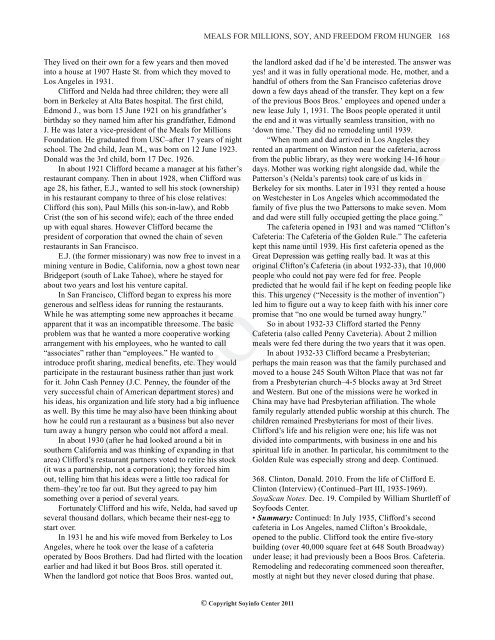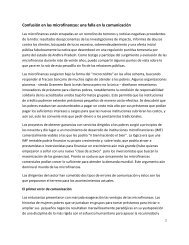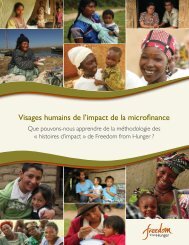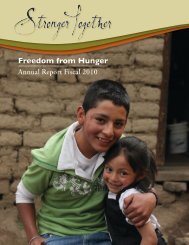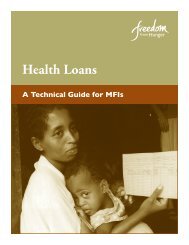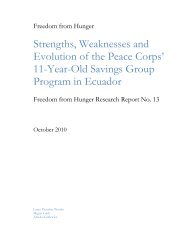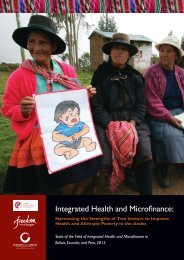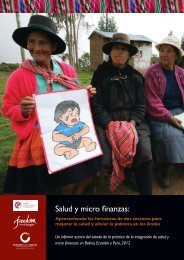history of meals for millions, soy, and freedom from ... - SoyInfo Center
history of meals for millions, soy, and freedom from ... - SoyInfo Center
history of meals for millions, soy, and freedom from ... - SoyInfo Center
Create successful ePaper yourself
Turn your PDF publications into a flip-book with our unique Google optimized e-Paper software.
They lived on their own <strong>for</strong> a few years <strong>and</strong> then moved<br />
into a house at 1907 Haste St. <strong>from</strong> which they moved to<br />
Los Angeles in 1931.<br />
Clif<strong>for</strong>d <strong>and</strong> Nelda had three children; they were all<br />
born in Berkeley at Alta Bates hospital. The first child,<br />
Edmond J., was born 15 June 1921 on his gr<strong>and</strong>father’s<br />
birthday so they named him after his gr<strong>and</strong>father, Edmond<br />
J. He was later a vice-president <strong>of</strong> the Meals <strong>for</strong> Millions<br />
Foundation. He graduated <strong>from</strong> USC–after 17 years <strong>of</strong> night<br />
school. The 2nd child, Jean M., was born on 12 June 1923.<br />
Donald was the 3rd child, born 17 Dec. 1926.<br />
In about 1921 Clif<strong>for</strong>d became a manager at his father’s<br />
restaurant company. Then in about 1928, when Clif<strong>for</strong>d was<br />
age 28, his father, E.J., wanted to sell his stock (ownership)<br />
in his restaurant company to three <strong>of</strong> his close relatives:<br />
Clif<strong>for</strong>d (his son), Paul Mills (his son-in-law), <strong>and</strong> Robb<br />
Crist (the son <strong>of</strong> his second wife); each <strong>of</strong> the three ended<br />
up with equal shares. However Clif<strong>for</strong>d became the<br />
president <strong>of</strong> corporation that owned the chain <strong>of</strong> seven<br />
restaurants in San Francisco.<br />
E.J. (the <strong>for</strong>mer missionary) was now free to invest in a<br />
mining venture in Bodie, Cali<strong>for</strong>nia, now a ghost town near<br />
Bridgeport (south <strong>of</strong> Lake Tahoe), where he stayed <strong>for</strong><br />
about two years <strong>and</strong> lost his venture capital.<br />
In San Francisco, Clif<strong>for</strong>d began to express his more<br />
generous <strong>and</strong> selfless ideas <strong>for</strong> running the restaurants.<br />
While he was attempting some new approaches it became<br />
apparent that it was an incompatible threesome. The basic<br />
problem was that he wanted a more cooperative working<br />
arrangement with his employees, who he wanted to call<br />
“associates” rather than “employees.” He wanted to<br />
introduce pr<strong>of</strong>it sharing, medical benefits, etc. They would<br />
participate in the restaurant business rather than just work<br />
<strong>for</strong> it. John Cash Penney (J.C. Penney, the founder <strong>of</strong> the<br />
very successful chain <strong>of</strong> American department stores) <strong>and</strong><br />
his ideas, his organization <strong>and</strong> life story had a big influence<br />
as well. By this time he may also have been thinking about<br />
how he could run a restaurant as a business but also never<br />
turn away a hungry person who could not af<strong>for</strong>d a meal.<br />
In about 1930 (after he had looked around a bit in<br />
southern Cali<strong>for</strong>nia <strong>and</strong> was thinking <strong>of</strong> exp<strong>and</strong>ing in that<br />
area) Clif<strong>for</strong>d’s restaurant partners voted to retire his stock<br />
(it was a partnership, not a corporation); they <strong>for</strong>ced him<br />
out, telling him that his ideas were a little too radical <strong>for</strong><br />
them–they’re too far out. But they agreed to pay him<br />
something over a period <strong>of</strong> several years.<br />
Fortunately Clif<strong>for</strong>d <strong>and</strong> his wife, Nelda, had saved up<br />
several thous<strong>and</strong> dollars, which became their nest-egg to<br />
start over.<br />
In 1931 he <strong>and</strong> his wife moved <strong>from</strong> Berkeley to Los<br />
Angeles, where he took over the lease <strong>of</strong> a cafeteria<br />
operated by Boos Brothers. Dad had flirted with the location<br />
earlier <strong>and</strong> had liked it but Boos Bros. still operated it.<br />
When the l<strong>and</strong>lord got notice that Boos Bros. wanted out,<br />
MEALS FOR MILLIONS, SOY, AND FREEDOM FROM HUNGER 168<br />
© Copyright Soyinfo <strong>Center</strong> 2011<br />
the l<strong>and</strong>lord asked dad if he’d be interested. The answer was<br />
yes! <strong>and</strong> it was in fully operational mode. He, mother, <strong>and</strong> a<br />
h<strong>and</strong>ful <strong>of</strong> others <strong>from</strong> the San Francisco cafeterias drove<br />
down a few days ahead <strong>of</strong> the transfer. They kept on a few<br />
<strong>of</strong> the previous Boos Bros.’ employees <strong>and</strong> opened under a<br />
new lease July 1, 1931. The Boos people operated it until<br />
the end <strong>and</strong> it was virtually seamless transition, with no<br />
‘down time.’ They did no remodeling until 1939.<br />
“When mom <strong>and</strong> dad arrived in Los Angeles they<br />
rented an apartment on Winston near the cafeteria, across<br />
<strong>from</strong> the public library, as they were working 14-16 hour<br />
days. Mother was working right alongside dad, while the<br />
Patterson’s (Nelda’s parents) took care <strong>of</strong> us kids in<br />
Berkeley <strong>for</strong> six months. Later in 1931 they rented a house<br />
on Westchester in Los Angeles which accommodated the<br />
family <strong>of</strong> five plus the two Pattersons to make seven. Mom<br />
<strong>and</strong> dad were still fully occupied getting the place going.”<br />
The cafeteria opened in 1931 <strong>and</strong> was named “Clifton’s<br />
Cafeteria: The Cafeteria <strong>of</strong> the Golden Rule.” The cafeteria<br />
kept this name until 1939. His first cafeteria opened as the<br />
Great Depression was getting really bad. It was at this<br />
original Clifton’s Cafeteria (in about 1932-33), that 10,000<br />
people who could not pay were fed <strong>for</strong> free. People<br />
predicted that he would fail if he kept on feeding people like<br />
this. This urgency (“Necessity is the mother <strong>of</strong> invention”)<br />
led him to figure out a way to keep faith with his inner core<br />
promise that “no one would be turned away hungry.”<br />
So in about 1932-33 Clif<strong>for</strong>d started the Penny<br />
Cafeteria (also called Penny Caveteria). About 2 million<br />
<strong>meals</strong> were fed there during the two years that it was open.<br />
In about 1932-33 Clif<strong>for</strong>d became a Presbyterian;<br />
perhaps the main reason was that the family purchased <strong>and</strong><br />
moved to a house 245 South Wilton Place that was not far<br />
<strong>from</strong> a Presbyterian church–4-5 blocks away at 3rd Street<br />
<strong>and</strong> Western. But one <strong>of</strong> the missions were he worked in<br />
China may have had Presbyterian affiliation. The whole<br />
family regularly attended public worship at this church. The<br />
children remained Presbyterians <strong>for</strong> most <strong>of</strong> their lives.<br />
Clif<strong>for</strong>d’s life <strong>and</strong> his religion were one; his life was not<br />
divided into compartments, with business in one <strong>and</strong> his<br />
spiritual life in another. In particular, his commitment to the<br />
Golden Rule was especially strong <strong>and</strong> deep. Continued.<br />
368. Clinton, Donald. 2010. From the life <strong>of</strong> Clif<strong>for</strong>d E.<br />
Clinton (Interview) (Continued–Part III, 1935-1969).<br />
SoyaScan Notes. Dec. 19. Compiled by William Shurtleff <strong>of</strong><br />
Soyfoods <strong>Center</strong>.<br />
• Summary: Continued: In July 1935, Clif<strong>for</strong>d’s second<br />
cafeteria in Los Angeles, named Clifton’s Brookdale,<br />
opened to the public. Clif<strong>for</strong>d took the entire five-story<br />
building (over 40,000 square feet at 648 South Broadway)<br />
under lease; it had previously been a Boos Bros. Cafeteria.<br />
Remodeling <strong>and</strong> redecorating commenced soon thereafter,<br />
mostly at night but they never closed during that phase.


